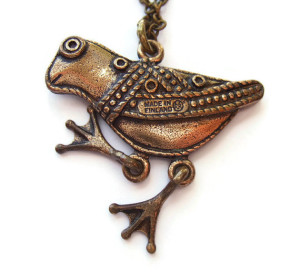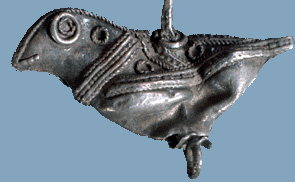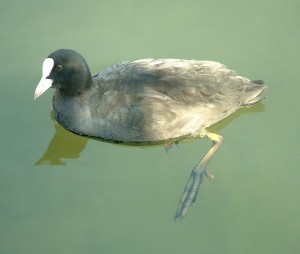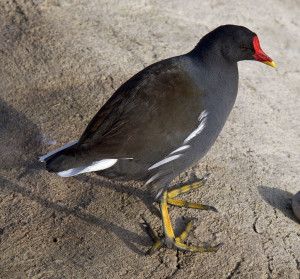I recently got this fab vintage piece for my Etsy shop, with its goofy face and its jiggly, dangly legs, and tried to find a bit more about it.

The bronze bird pendant necklace by Kalevala Koru, based on a silver Viking bird pendant from Hattula, Finland. For sale in my Etsy shop: click on photo for details. (NOW SOLD).
I knew it was made by the Finnish jewellery firm of Kalevala Koru of Helsinki, one of the largest jewellery firms in Finland, and a further google truffle told me it was designed by Kimmo Virkkunen. I also learned that it was based on a late Viking-era hoard find. My ears pricked up. I love me a hoard.
Here’s the original on which the modern iteration is based:
The caption in Finnish on the National Board of Antiquities webpage translates as ‘The bird-shaped pendant in silver is decorated with filigree. The pendant is part of a silver treasure found in Luurila in Hattula’.
A further google truffle tells me that the hoard was found in a field, part of a farm called Luurila in the municipality of Hattula in south-central Finland, near the village of Pelkola. The farm is on the south-west shore of Lake Renkojärvi. It is thought that the hoard was originally buried in a leather bag or some other container that had disintegrated; the ploughing of the field had spread the contents over an area of about 25 m². In 1906, after a few coins and a pendant had been found in the field, the site was excavated by the National Museum, and produced a significant number of finds.
The pendant dates from between 800-1025 AD, and the hoard was buried around 1040 AD. The hoard comprised silver necklets, pendants, and strap mounts, carnelian and glass beads, and 126 silver coins, including Anglo-Saxon ones from England and Byzantine ones with Kufic Arabic. The coins allowed the date of deposition of the hoard to be established to a very close date.
The pendant is made of sheet silver, with a filigree decoration. The bird’s legs are missing, but the suspension loop from which they presumably would have hung survives. The modern version by Kalevala Koru gives the bird the long, webbed feet of a waterfowl. Given the preponderance of lakes and inland waterways in Finland (there are over 55,000 lakes there, according to Wikipedia, which rather knock the 4,000 holes in Blackburn, Lancashire into a cocked hat), and the shape of the bird’s body, this does not seem like an unreasonable interpretation. It reminds me of a coot (Fulica atra) or a moorhen (Gallinula chloropus):
but as the moorhen doesn’t have webbed feet I guess the Kalevala Koru one at least can’t be that.
Most of the information on the hoard in this post comes from Anglo-Saxon Coins Found in Finland by C.A. Nordman, published in Helsingfors in 1921 and which has been digitised and made available on the web by the University of Illinois as part of its Brittle Books Project. Hurrah for UIUC!


